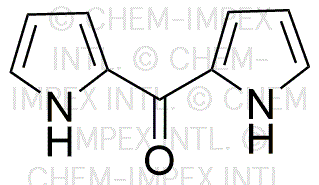5-Dipyrrylketone is widely utilized in research focused on:
- Coordination Chemistry: This compound serves as a versatile ligand in coordination complexes, enhancing the properties of metal ions in various applications, including catalysis and materials science.
- Fluorescent Probes: Its unique structure allows it to be used in the development of fluorescent probes for biological imaging, aiding researchers in visualizing cellular processes with high specificity.
- Organic Synthesis: 5-Dipyrrylketone is valuable in organic synthesis for creating complex molecules, offering a pathway to produce pharmaceuticals and agrochemicals efficiently.
- Electrochemical Sensors: The compound is employed in the fabrication of electrochemical sensors, providing sensitive detection of various analytes, which is crucial in environmental monitoring and food safety.
- Photovoltaic Devices: Its properties are harnessed in the development of organic photovoltaic devices, contributing to advancements in renewable energy technologies.
General Information
Properties
Safety and Regulations
Applications
5-Dipyrrylketone is widely utilized in research focused on:
- Coordination Chemistry: This compound serves as a versatile ligand in coordination complexes, enhancing the properties of metal ions in various applications, including catalysis and materials science.
- Fluorescent Probes: Its unique structure allows it to be used in the development of fluorescent probes for biological imaging, aiding researchers in visualizing cellular processes with high specificity.
- Organic Synthesis: 5-Dipyrrylketone is valuable in organic synthesis for creating complex molecules, offering a pathway to produce pharmaceuticals and agrochemicals efficiently.
- Electrochemical Sensors: The compound is employed in the fabrication of electrochemical sensors, providing sensitive detection of various analytes, which is crucial in environmental monitoring and food safety.
- Photovoltaic Devices: Its properties are harnessed in the development of organic photovoltaic devices, contributing to advancements in renewable energy technologies.
Documents
Safety Data Sheets (SDS)
The SDS provides comprehensive safety information on handling, storage, and disposal of the product.
Product Specification (PS)
The PS provides a comprehensive breakdown of the product’s properties, including chemical composition, physical state, purity, and storage requirements. It also details acceptable quality ranges and the product's intended applications.
Certificates of Analysis (COA)
Search for Certificates of Analysis (COA) by entering the products Lot Number. Lot and Batch Numbers can be found on a product’s label following the words ‘Lot’ or ‘Batch’.
*Catalog Number
*Lot Number
Certificates Of Origin (COO)
This COO confirms the country where the product was manufactured, and also details the materials and components used in it and whether it is derived from natural, synthetic, or other specific sources. This certificate may be required for customs, trade, and regulatory compliance.
*Catalog Number
*Lot Number
Safety Data Sheets (SDS)
The SDS provides comprehensive safety information on handling, storage, and disposal of the product.
DownloadProduct Specification (PS)
The PS provides a comprehensive breakdown of the product’s properties, including chemical composition, physical state, purity, and storage requirements. It also details acceptable quality ranges and the product's intended applications.
DownloadCertificates of Analysis (COA)
Search for Certificates of Analysis (COA) by entering the products Lot Number. Lot and Batch Numbers can be found on a product’s label following the words ‘Lot’ or ‘Batch’.
*Catalog Number
*Lot Number
Certificates Of Origin (COO)
This COO confirms the country where the product was manufactured, and also details the materials and components used in it and whether it is derived from natural, synthetic, or other specific sources. This certificate may be required for customs, trade, and regulatory compliance.


